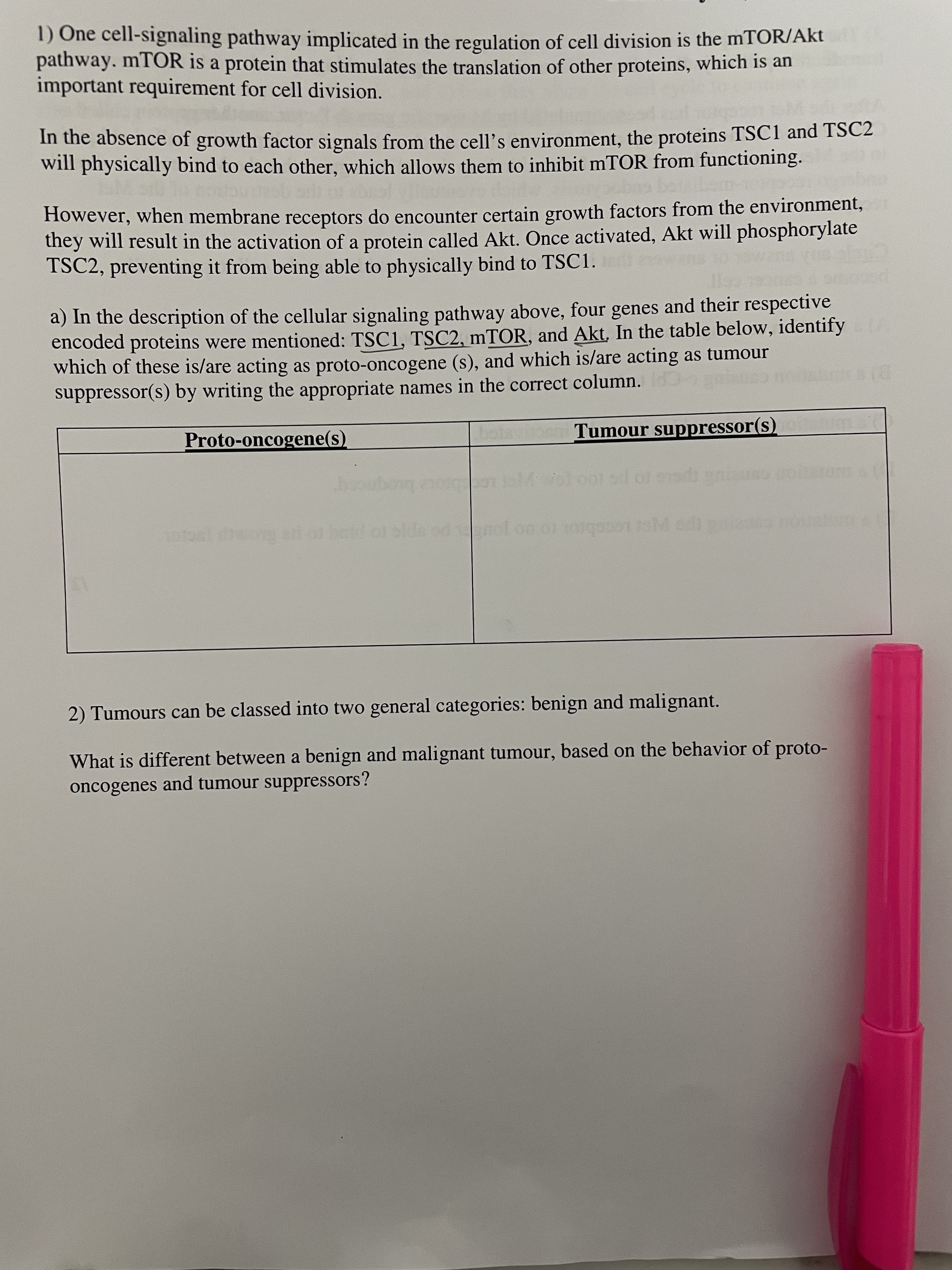1) One cell-signaling pathway implicated in the regulation of cell division is the mTOR/Akt pathway. 'TOR is a protein that stimulates the translation of other proteins, which is an important requirement for cell division. In the absence of growth factor signals from the cell's environment, the proteins TSC1 and TSC2 will physically bind to each other, which allows them to inhibit mTOR from functioning. However, when membrane receptors do encounter certain growth factors from the environment, they will result in the activation of a protein called Akt. Once activated, Akt will phosphorylate TSC2, preventing it from being able to physically bind to TSC1.
1) One cell-signaling pathway implicated in the regulation of cell division is the mTOR/Akt pathway. 'TOR is a protein that stimulates the translation of other proteins, which is an important requirement for cell division. In the absence of growth factor signals from the cell's environment, the proteins TSC1 and TSC2 will physically bind to each other, which allows them to inhibit mTOR from functioning. However, when membrane receptors do encounter certain growth factors from the environment, they will result in the activation of a protein called Akt. Once activated, Akt will phosphorylate TSC2, preventing it from being able to physically bind to TSC1.
Biology 2e
2nd Edition
ISBN:9781947172517
Author:Matthew Douglas, Jung Choi, Mary Ann Clark
Publisher:Matthew Douglas, Jung Choi, Mary Ann Clark
Chapter9: Cell Communication
Section: Chapter Questions
Problem 1VCQ: Figure 9.8 HER2 is a receptor tyrosine kinase. In 30 percent of human breast cancers, HER2 is...
Related questions
Question

Transcribed Image Text:1) One cell-signaling pathway implicated in the regulation of cell division is the mTOR/Akt
pathway. mTOR is a protein that stimulates the translation of other proteins, which is an
important requirement for cell division.
In the absence of growth factor signals from the cell's environment, the proteins TSC1 and TSC2
will physically bind to each other, which allows them to inhibit mTOR from functioning.
However, when membrane receptors do encounter certain growth factors from the environment,
they will result in the activation of a protein called Akt. Once activated, Akt will phosphorylate
TSC2, preventing it from being able to physically bind to TSC1.
a) In the description of the cellular signaling pathway above, four genes and their respective
encoded proteins were mentioned: TSC1, TSC2, mTOR, and Akt, In the table below, identify
which of these is/are acting as proto-oncogene (s), and which is/are acting as tumour
suppressor(s) by writing the appropriate names in the correct column.
Proto-oncogene(s)
Tumour suppressor(s)
2) Tumours can be classed into two general categories: benign and malignant.
What is different between a benign and malignant tumour, based on the behavior of proto-
oncogenes and tumour suppressors?
Expert Solution
This question has been solved!
Explore an expertly crafted, step-by-step solution for a thorough understanding of key concepts.
Step by step
Solved in 5 steps

Knowledge Booster
Learn more about
Need a deep-dive on the concept behind this application? Look no further. Learn more about this topic, biology and related others by exploring similar questions and additional content below.Recommended textbooks for you

Biology 2e
Biology
ISBN:
9781947172517
Author:
Matthew Douglas, Jung Choi, Mary Ann Clark
Publisher:
OpenStax

Biology 2e
Biology
ISBN:
9781947172517
Author:
Matthew Douglas, Jung Choi, Mary Ann Clark
Publisher:
OpenStax